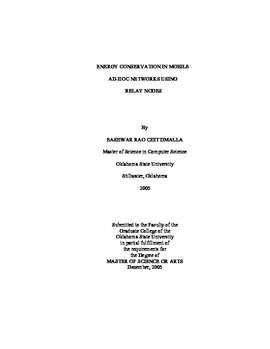| dc.contributor.advisor | Sarangan, Venkatesh | |
| dc.contributor.author | Chittimalla, Eashwar Rao | |
| dc.date.accessioned | 2014-04-15T18:30:58Z | |
| dc.date.available | 2014-04-15T18:30:58Z | |
| dc.date.issued | 2005-12-01 | |
| dc.identifier.uri | https://hdl.handle.net/11244/8135 | |
| dc.description.abstract | MANET (mobile ad-hoc network) is a self organizing and self-configuring multi hop wireless network. The mobile nodes are normally dedicated to a particular task. Energy conservation in the nodes is a critical issue that can affect the performance of the network drastically. The current methods of saving energy tend to interfere in the normal working of the node thus disrupting the application. The work brings in a new scheme of saving the energy in communication by introducing into the network dedicated, mobility controllable nodes called 'relay nodes' whose working protocols was developed in the thesis. The relay node is governed by a set of equations which determine the flows that the relay node would be handling. This layer operates above the routing layer in the protocol stack. The results conclude that the relay node protocol can save significant energy in the MANET. For a maximum energy savings, single hop network should have higher Epoch time and a multi hop should have a in between Epoch time. Global view generates better results than compared to the Local view though obtaining global view might put and additional burden on the network. Max flow strategy works better than a random flow scenario thus justifying the use of the equations to choose the flows. To obtain Max flow the relay node has to use the equations and calculate the flows it would be servicing using the equations developed. In comparison with other protocols, the relay node approach is much cleaner and equally efficient approach. The relay node protocol does not interfere with the normal working of the MANET node and moulds its working in according with the network situation to conserver power in the MANET node. The MANET node is free from the burden of being concerned with saving of power which could result in sub optimal performance of the application running in the MANET node. The relay node is now responsible for saving power. The MANET nodes can now dedicate themselves completely to the application task. In conclusion we can say that the relay node the relay node approach can save significant energy and thus prolong the longevity of the MANET node in the network. | |
| dc.format | application/pdf | |
| dc.language | en_US | |
| dc.publisher | Oklahoma State University | |
| dc.rights | Copyright is held by the author who has granted the Oklahoma State University Library the non-exclusive right to share this material in its institutional repository. Contact Digital Library Services at lib-dls@okstate.edu or 405-744-9161 for the permission policy on the use, reproduction or distribution of this material. | |
| dc.title | Energy Conservation in Mobile Ad-hoc Networks Using Relay Nodes | |
| dc.type | text | |
| dc.contributor.committeeMember | Thomas, Johnson | |
| dc.contributor.committeeMember | Park, N. | |
| osu.filename | Chittimalla_okstate_0664M_1555.pdf | |
| osu.college | Arts and Sciences | |
| osu.accesstype | Open Access | |
| dc.description.department | Computer Science Department | |
| dc.type.genre | Thesis | |
| dc.subject.keywords | energy conservation in mobile ad-hoc networks | |
